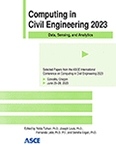Workers’ Perception and Acceptance of Collaborative Robots in Construction Using the Technology Acceptance Model
Publication: Computing in Civil Engineering 2023
ABSTRACT
The adoption of collaborative robots in construction is one major step toward achieving intelligent and automated construction to improve productivity and safety. Many construction tasks require physical human-robot collaboration (HRC), where workers and robots collaborate side-by-side in a common workspace. Such close-distance interactions may cause worker resistance, hindering successful HRC implementation. This study aims to understand workers’ acceptance of HRC via experimental studies. Experiments on human-robot collaborative wood assembly were performed, where participants were tasked to connect wood pieces, and a robot was programmed to place pieces according to design. Two designs with different complexity levels were given. Surveys adapted from technology acceptance model were collected before and after the experiments to investigate individual perceptions and acceptance of robots. The results show that gender and complexity of tasks have a great impact on the acceptance of robots. Finally, the implications for the future development of HRC in construction were discussed.
Get full access to this article
View all available purchase options and get full access to this chapter.
REFERENCES
Bock, T. (2015). The future of construction automation: Technological disruption and the upcoming ubiquity of robotics. Automation in Construction, 59, 113–121. https://doi.org/10.1016/j.autcon.2015.07.022.
Bröhl, C., Nelles, J., Brandl, C., Mertens, A., and Schlick, C. M. (2016). TAM Reloaded: A Technology Acceptance Model for Human-Robot Cooperation in Production Systems. In C. Stephanidis (Ed.), HCI International 2016 – Posters’ Extended Abstracts (pp. 97–103). Springer International Publishing. https://doi.org/10.1007/978-3-319-40548-3_16.
Davila Delgado, J. M., Oyedele, L., Ajayi, A., Akanbi, L., Akinade, O., Bilal, M., and Owolabi, H. (2019). Robotics and automated systems in construction: Understanding industry-specific challenges for adoption. Journal of Building Engineering, 26, 100868. https://doi.org/10.1016/j.jobe.2019.100868.
Davis, F. D. (1989). Perceived Usefulness, Perceived Ease of Use, and User Acceptance of Information Technology. MIS Quarterly, 13(3), 319–340. https://doi.org/10.2307/249008.
Gross Domestic Product, (Third Estimate), GDP by Industry, and Corporate Profits, Fourth Quarter and Year 2020 | U.S. Bureau of Economic Analysis (BEA). (2021). Retrieved March 8, 2023, from https://www.bea.gov/news/2021/gross-domestic-product-third-estimate-gdp-industry-and-corporate-profits-4th-quarter-and.
Law, K. K., Chang, S., and Siu, M.-F. F. (2022). Factors Influencing Adoption of Construction Robotics in Hong Kong’s Industry: A Multistakeholder Perspective. Journal of Management in Engineering, 38(2), 04021096. https://doi.org/10.1061/(ASCE)ME.1943-5479.0001011.
Liang, C.-J., Wang, X., Kamat, V. R., and Menassa, C. C. (2021). Human–Robot Collaboration in Construction: Classification and Research Trends. Journal of Construction Engineering and Management, 147(10), 03121006. https://doi.org/10.1061/(ASCE)CO.1943-7862.0002154.
Lingard, H. (2013). Occupational health and safety in the construction industry. Construction Management and Economics, 31(6), 505–514. https://doi.org/10.1080/01446193.2013.816435.
Lotz, V., Himmel, S., and Ziefle, M. (2019). You’re My Mate – Acceptance Factors for Human-Robot Collaboration in Industry. https://www.semanticscholar.org/paper/You%E2%80%99re-My-Mate-%E2%80%93-Acceptance-Factors-for-Human-Robot-Lotz-Himmel/d50f7fb24d25bbebd7c44050446037868327c338.
Marangunić, N., and Granić, A. (2015). Technology acceptance model: A literature review from 1986 to 2013. Universal Access in the Information Society, 14(1), 81–95. https://doi.org/10.1007/s10209-014-0348-1.
BLS (Bureau of Labor Statistics). (2020). National Census of Fatal Occupational Injuries in 2019,. BLS, Washington, DC.
Park, S., Yu, H., Menassa, C. C., and Kamat, V. R. (2023). A Comprehensive Evaluation of Factors Influencing Acceptance of Robotic Assistants in Field Construction Work. Journal of Management in Engineering, 39(3), 04023010. https://doi.org/10.1061/JMENEA.MEENG-5227.
Venkatesh, V. (2000). Determinants of Perceived Ease of Use: Integrating Control, Intrinsic Motivation, and Emotion into the Technology Acceptance Model. Information Systems Research, 11(4), 342–365. https://doi.org/10.1287/isre.11.4.342.11872.
Venkatesh, V., and Bala, H. (2008). Technology Acceptance Model 3 and a Research Agenda on Interventions. Decision Sciences, 39(2), 273–315. https://doi.org/10.1111/j.1540-5915.2008.00192.x.
Information & Authors
Information
Published In
History
Published online: Jan 25, 2024
ASCE Technical Topics:
- Automation and robotics
- Building materials
- Business management
- Construction engineering
- Construction management
- Construction sites
- Design (by type)
- Employment
- Engineering fundamentals
- Engineering materials (by type)
- Human and behavioral factors
- Labor
- Load and resistance factor design
- Load factors
- Materials engineering
- Occupational safety
- Personnel management
- Practice and Profession
- Productivity
- Public administration
- Public health and safety
- Safety
- Structural design
- Systems engineering
- Wood and wood products
- Work zones
Authors
Metrics & Citations
Metrics
Citations
Download citation
If you have the appropriate software installed, you can download article citation data to the citation manager of your choice. Simply select your manager software from the list below and click Download.
